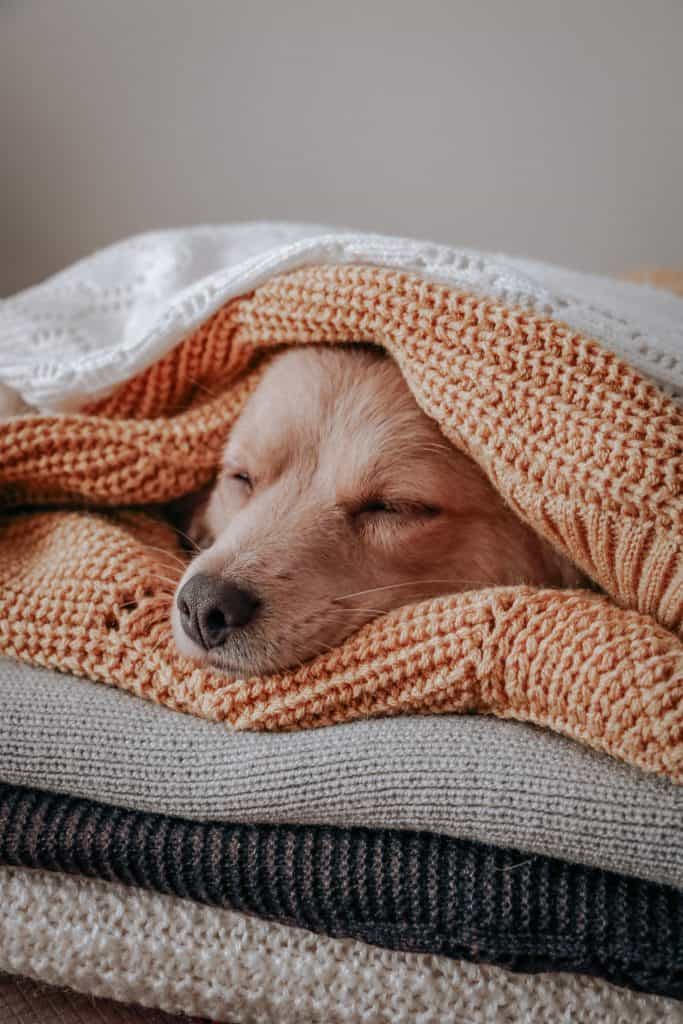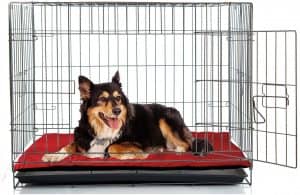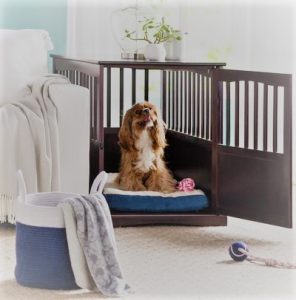When it comes to puppies, there is a lot of debate over when they are ready to sleep out of their crate. Some say you can move the puppy to a regular bed as soon as it is potty trained. Others recommend waiting until the puppy is at least ten months old. There isn’t a specific age at which dogs should be transitioned out of their crates, as every dog is unique! Generally, it takes 12 to 24 months for your dog to learn how to sleep outside the crate, regardless of breed.
If your dog is toilet trained, has no chewing or destructive tendencies when left unattended, and sleeps in the crate peacefully through the night without causing any disturbances, they may be ready to sleep out of their crate. However, if your dog is still having accidents in the house, destroying things when left alone, or waking you up in the middle of the night, they are probably not ready to sleep out of their crate.
New puppies are a lot of work, but they are also a lot of fun. One of the most significant decisions you will make as a puppy owner is when to transition your pup from sleeping in a crate to sleeping in a regular bed. There are several factors to consider when making this decision, including your dog’s behaviour, potty training, chewing habits, and separation anxiety.

The benefits of crate training for puppies
Crates are often seen as a necessary evil for puppy parents, but they can be a valuable tool for training, housebreaking, and bonding. When used correctly, crates can provide puppies with a safe and cozy space to call their own.
Puppies crate-trained are less likely to have accidents in the house and are better equipped to handle separation anxiety. Additionally, crates can help puppies feel more secure in new and unfamiliar environments.
By crate-training your puppy from an early age, you can set them up for success in the years to come.
Related read: Where should dogs sleep.
How to Crate Train Your Puppy
Crate training is not rocket science. Puppies have an instinct to relieve themselves in their sleeping area, so using a crate will help to teach your puppy that he needs to hold it until he can go outside.
Here are some tips for crate training your puppy:
- Choose the right size crate. Your puppy should be able to stand up and turn around in the crate. It shouldn’t be too large, or your dog will use the crate at night as a bathroom.
- Put the crate where your puppy spends a lot of time, such as in the living room or bedroom. This will help him get used to being in the crate and make it less scary.
- Get your puppy comfortable in the crate by feeding him his meals and placing some toys inside. You can even put a blanket or pillow there for him to lie on.
- When it’s time to start potty training, take your puppy outside frequently and take him straight to his designated potty spot when you let him out of the crate. Reward him with praise or treats when he goes in the proper spot.
- Crate time should be limited at first, gradually increasing as your puppy gets more comfortable with being in the crate. Once he is fully potty trained and can stay in the crate for longer without having accidents, you can start to leave him in there for longer.

When is puppy ready to sleep out of crate?
A puppy pen can provide a safe, secure space for your dog to rest and sleep. It’s important to ensure your dog has a comfortable, positive place to lounge during the day. A dog bed is a perfect solution.
Transforming your puppy’s sleeping arrangements from his crate onto his bed can be daunting, but it doesn’t have to be! Here are six tips to make the process easy and stress-free:
Choose the right dog bed.
Just like with crates, you’ll want to ensure the bed is the proper size for your puppy. It should be big enough to stretch out and move around but not so large that he feels lost in it.
When choosing a dog bed for your puppy, pick a comfortable one and the correct size. You may also want to consider getting a bed that is easy to clean, as puppies can be messy!
Tip: Don’t let your puppy sleep in your bed, as this can create separation anxiety when left alone.
Put the bed in a familiar place.
When your puppy is ready to sleep out of his crate, put the bed in a familiar place. Puppies feel safest when in familiar surroundings, so try to put the bed in the same room as his crate or where he usually sleeps.
Introduce your puppy to the bed slowly.
If you’re introducing your puppy to a bed for the first time, start by putting the bed in a quiet, low-traffic area of your home. Let him sniff it and explore it at his own pace. Once your puppy is comfortable going to bed and relaxing on it, you can gradually move it to a more open space in your home.
Get him used to sleeping in the bed by taking short naps.
Start by taking short naps with your puppy in his bed. This will help him get used to sleeping in the bed and make the transition from crate to bed easier. Encourage your puppy to sleep in his bed at night. When it’s time for bed, put your puppy in his bed and give him a toy or a bone. Just remember to take things slowly and let your puppy get used to his new bed at his own pace.
Be consistent with your house rules.
Once you’ve decided to transition your puppy to a regular bed, ensure everyone in the household is on board. Consistency is vital in training, so having everyone on the same page will make things easier for you and your puppy. Also, make sure you puppy-proof the room where your pup will be staying like there’s nothing to chew on or things that might fall and break, etc… We recommend using baby gates to confine them to one or a few rooms.
Reward good behavior.
As always, positive reinforcement is a powerful tool when it comes to training your puppy. When he sleeps in his bed all night without incident, give him a treat or some extra attention to let him know he’s done an excellent job.
The goal is for your puppy to be fully housebroken before he can roam the house freely for a smooth transition.
Related read: Dog bedtime routine.
Is it cruel for dog owners to crate a puppy at night?
Many dog owners crate their puppies at night. They may feel guilty about it, but many do it anyway. The puppy cries and whines for a while but eventually falls asleep. The door is closed, and the puppy is alone in the dark. Is this cruel?
There are a few things to consider. First, many puppies cry when you put them in their crates. This is normal, and they will eventually get used to it. Second, puppies need to sleep a lot. They need to get used to being in their own space to sleep through the night. Third, many dogs enjoy having a place to call their own. A crate can provide them with a sense of security and safety.
If you’re transitioning your puppy out of the crate and onto his bed, you may leave the door open at first so he can come and go as he pleases. You can also put a blanket or toy in the crate to make it more comfortable for him.
Potty training your puppy
For many puppy owners, the process of crate training is an essential part of potty training. By crate training your puppy and keeping them in a crate overnight, you can help prevent accidents in the house. Make it easier for your puppy to transition to a life outside the crate.
However, crate training is not a magic solution. Remember, you still need to take your puppy out frequently during their first few weeks at home. In addition, crate training should be combined with other dog training methods, such as positive reinforcement, to ensure your puppy grows well-behaved.
With patience and consistency, you can successfully potty train your puppy and transition them out of the crate.
How often should I crate my puppy during the day?
Forcing a puppy to stay in a crate all day is unnecessary. Puppies need to be able to move around and explore their environment to learn and grow. However, there are times when crate training can be beneficial, such as when you’re potty training or if your puppy is teething and chewing on everything in sight.
If you need to crate your puppy during the day, let them out every few hours for a potty break and stretch their legs. It would be best if you also placed the crate in a peaceful spot in the home where the puppy can relax and not be disturbed.
As a general rule, a two-month-old pup should be taken out of the crate every 2 hours, while you should take a four-month-old puppy out of the crate every 4 hours.
You may leave the crate open during the day.
Should I let my puppy out of his crate when he cries?
Puppy crying is difficult to listen to, but it’s essential to be patient and consistent when crate training.
It’s tough to know what to do if your puppy cries in his crate. On the one hand, giving him a sense of security and familiar surroundings is important. On the other hand, you don’t want him to feel isolated or ignored. So what’s the best course of action?
The answer may vary depending on the individual puppy, but you can follow some general guidelines.
If you let your puppy out of the crate every time he cries, he will learn that crying equals freedom. The crate will no longer be an effective tool for training.
Instead, wait until your puppy is calm before letting him out of the crate. This may take some time, but it will be worth it in the long run.
Tip: Leave some chewing toys in the crate, as your dog might be teething.
Leave the crate door open!
Leave the crate door open when you’re home so your puppy can come and go as he pleases. This will help him get used to his crate and make it a more positive experience. If you have to leave him in his crate when you’re not home, try putting something in there that he likes, such as a toy or a treat.
Transitioning your puppy to a regular dog bed.
The following are pointers to assist dog owners in determining when their puppy is ready to sleep outside the crate on its dog bed:
- Potty Training: One of the most important factors to consider when transitioning your puppy to sleeping in a regular bed is potty training. If your puppy is not yet potty trained, they will likely have accidents in their new bed. Ensure your puppy is fully potty trained before moving to a regular bed.
- Chewing Habits: Puppies are notorious for chewing on things, including beds. If your puppy is still in the teething phase, they may be more likely to chew on their bed. To avoid this, provide him with chew toys, and wait until your puppy is past the teething phase before transitioning them to a regular bed.
- Separation Anxiety: If your new puppy suffers from separation anxiety, they may not sleep well in a regular bed by themselves. If this is the case, you may want to wait to transition your puppy to a regular bed until its separation anxiety has improved. Most dogs outgrow separation anxiety by around six months old.
- Sleeping Schedule: Puppies sleep a lot. Considering their sleeping schedule when transitioning to a regular bed is important. If your puppy is used to sleeping in a crate, it may not be used to sleeping in a bed for long periods. To avoid this, gradually increase your puppy’s time in their new dog bed until they sleep through the night.
- Size: The size of your puppy will also be a factor when transitioning them to a regular bed. Your puppy may feel lost in a larger bed if it is small. In this case, waiting until your puppy is a bit bigger may be better.
- Comfort Level: You will need to consider your puppy’s comfort level when transitioning to a regular dog bed. If your puppy is comfortable sleeping in its crate, it may not be ready to sleep in a regular bed. It is best to wait until your puppy is comfortable with the idea of sleeping in a regular bed before making the transition.
Conclusion
So when is my puppy ready to sleep out of the crate?
Transitioning your puppy from sleeping in a crate to sleeping in a regular bed can be tricky. There are many factors to consider, such as the puppy’s age, chewing habits, separation anxiety, and sleeping schedule. It is important to consider each of these when determining when your pup is ready for the transition. Some puppies may be ready for the change sooner than others. It is essential to listen to your puppy and see when they are comfortable making the switch to have a successful transition. Puppy proofing your home is crucial before your puppy is ready to sleep outside the crate. Puppies can be playful and destructive.
If you have any questions or concerns, please consult with your veterinarian. They will be able to help you get your puppy ready for the transition and offer any other advice on the matter.
Recent Posts
As a dog owner, you want to ensure that you take proper care of your furry companion. A common question that many pet owners have is, "Can I walk my dog 30 minutes after eating?" Understanding the...
Have you ever considered getting an elevated dog bed for your furry friend, but wondered if it's worth the investment? If so, you're not alone. As dog owners, we all want to provide the best care for...






